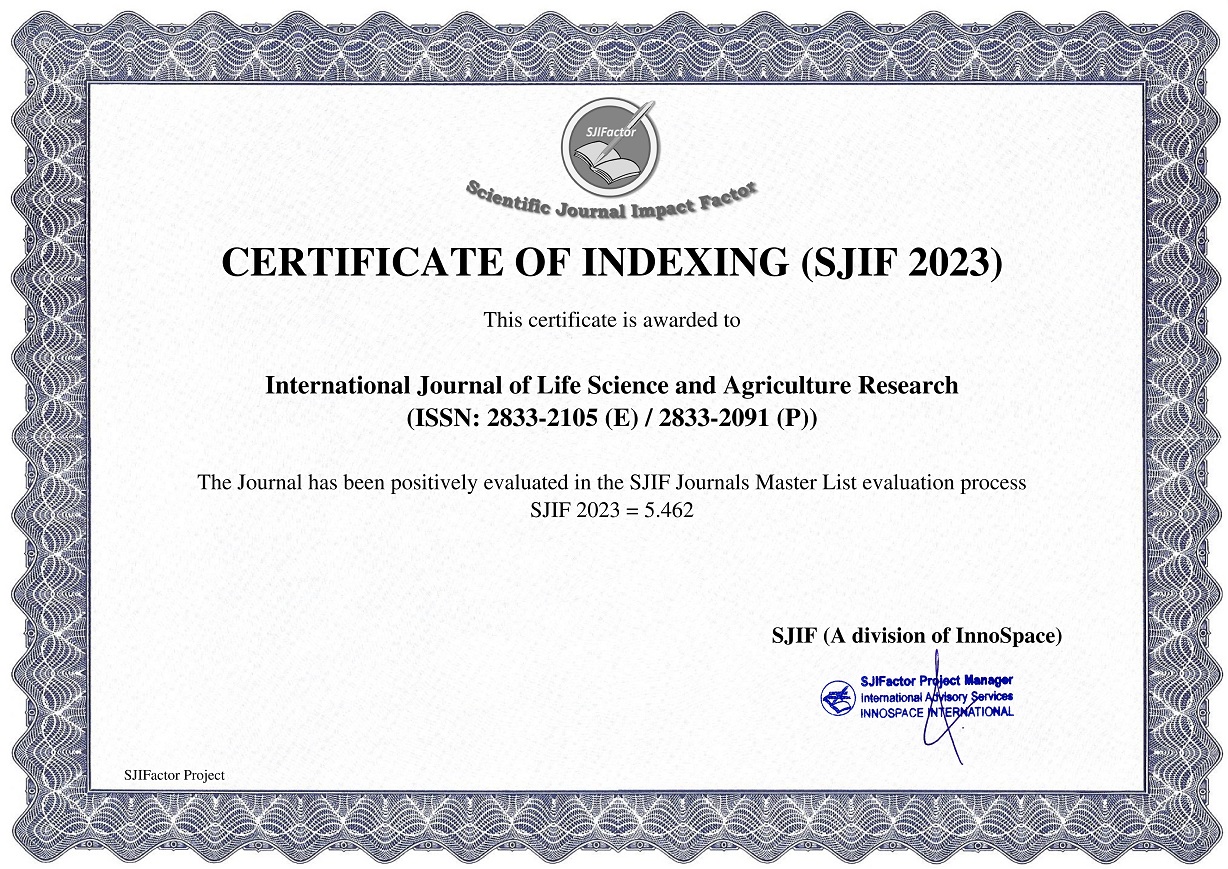Effect of NPK Bio-Organomineral Tablet Fertilizer on Harvest Index, Wet Weight, Dry Weight and Fertilization Efficiency in the Waste Contaminated Soil
DOI:
https://doi.org/10.55677/ijlsar/V03I3Y2024-04Keywords:
Slow-release fertilizer, rice production, industrial waste.Abstract
Contamination of rice fields due to industrial activities had an impact on reduced soil fertility, heavy metal contamination from industrial waste, and reduced rice yields. To overcomed this problem, this could be done by applied NPK Bio-organomineral tablet fertilizer. NPK Bio-organomineral tablet fertilizer was a modification of fertilizer made from urea, guano, palm oil empty fruit bunch charcoal, zeolite, activated charcoal, and biologically enhanced compost, turning the fertilizer into a slow-release form. The experiment aimed to investigate the impact of applied NPK Bio organomineral tablet fertilizer on harvest index, wet weight, dry weight and fertilization efficiency in the waste contaminated soil. This experiment was conducted from September 2023 to January 2024 at the Greenhouse Experimental Garden of Ciparanje, Jatinangor, and the Soil Fertility and Plant Nutrition Laboratory, Universitas Padjadjaran. The experimental design used was a Randomized Block Design (RBD) consisted of eight treatments and four replications, included control, NPK Phonska 100% recommendation 250 kg/ha, and 125; 250; 375; 500; 625; 750 kg/ha of NPK Bio-organomineral tablet fertilizer. The results of the experiment indicated that NPK Bio-organomineral tablet fertilizer had an impact on harvest index, wet weight, dry weight and fertilization efficiency in the waste contaminated soil. The optimal dose of NPK Bio-organomineral tablet fertilizer was 375 kg/ha, showed the most significant improvement on harvest index, wet weight, dry weight and fertilization efficiency in the waste contaminated soil.
References
Afrida, A., Setya, A. H., & Taher, Y. A. (2022). Pengaruh POC urine kambing terhadap pertumbuhan bibit kelapa sawit (Elaeis guineensis Jacq.) pada fase main nursery untuk menekan biaya produksi. Jurnal Ekonomi dan Bisnis Dharma Andalas, 24(1), 13-22. http://jurnal.unidha.ac.id/index.php/JEBD /article/download/318/245
Iswahyudi, I. (2018). Pengaruh pemberian pupuk NPK dan biochar terhadap pertumbuhan dan hasil padi sawah (Oryza sativa L.). Jurnal Penelitian Agrosamudra, 5(1), 14-23. https://ejurnalunsam.id/index.php/jagrs/article/ view/810
Juarsah, I. (2016). Pemanfaatan zeolit dan dolomit sebagai pembenah untuk meningkatkan efisiensi pemupukan pada lahan sawah. Jurnal Agro, 3(1), 10-19. https://doi.org/10.15575/807
Kasno, A., Setyorini, D., & Widowati, Ladiyani R. (2021). Evaluasi karakteristik, sumbangan hara K air irigasi dan jerami serta respon pemupukan hara kalium pada lahan sawah. Agric Jurnal Ilmu Pertanian, 33(2), 189-199. ejournal.uksw.edu/agric
Ministry of Agriculture Indonesia (2022). Regulation of the Minister of Agriculture Indonesia Number 13 of 2022 concerning the Use of NPK Fertilizer Doses for Rice, Corn and Soybean Crops on Rice Fields. Balai Penelitian dan Pengembangan Pertanian, Ministry of Agriculture Indonesia, Jakarta.
Mulyono, A., Rachmat, A., Dewi, I. R., & Rusydi, A. F. (2010). Aplikasi mikoriza dalam remediasi lahan tercemar limbah industri tekstil (Studi kasus : Persawahan di kawasan industri Rancaekek). Puslit Geoteknologi LIPI, 5(1) 277-284. https://jrisetgeotam.lipi.go.id/index.php /article/view/720.
Safriyani, E., Hasmeda, M., Munandar, M., & Sulaiman, F. (2018). Korelasi komponen pertumbuhan dan hasil pada pertanian terpadu padi-azolla. Jurnal Lahan Suboptimal: Journal of Suboptimal Lands, 7(1), 59-65. https://doi.org/10.33230/JLSO.7.1.2018.344
Salam, A. K. (2020). Ilmu Tanah (2nd ed., Vol. 1). Global Madani Press. Jakarta. www.globalmadani.sch.id.
Salisbury, F. B. dan C. W. Ross. (1995). Fisiologi Tumbuhan. Jilid I. Edisi IV. ITB, Bandung.
Sasminto, A. T., & Sularno, S. (2018). Efektivitas konsentrasi pupuk cair hayati terhadap pertumbuhan dan produksi padi sawah (Oryza sativa L.) Prosiding SEMNASTAN, 220-228. https://jurnal.umj.ac.id/index.php/semnastan/arti cle/view/2278
Sitompul, H. F., Simanungkalit, T., & Mawarni, L. L. (2014). Respons pertumbuhan bibit kakao (Theobroma cacao L.) terhadap pemberian pupuk kandang kelinci dan pupuk NPK (16:16:16). Jurnal Agroekoteknologi Universitas Sumatera Utara, 2(3), 1064-1072. https://dx.doi.org/10.32734/jaet.v2i3.74 62
Sitorus, U. K. P., Siagian, B., & Rahmawati, N. (2014). Respons pertumbuhan bibit kakao (Theobroma cacao L.) terhadap pemberian abu boiler dan pupuk urea pada media pembibitan. Jurnal Online Agroekoteknologi. 2(3), 1021-1029. https://dx.doi.org/10.32734/ jaet.v2i3.7455
Subandi, M., Hasani, S., & Satriawan, W. (2016). Tingkat efisiensi dan efektivitas pupuk hayati dalam mensubstitusi pupuk nitrogen dan fosfor pada tanaman jagung (Zea mays L.). Jurnal Agrista, 20(3), 140-149. https://jurnal.usk.ac .id/agrista/article/view/10514
Sudirja, R., Joy, B., & Rosniawaty, D. S. (2017). Penerapan produk pupuk pada tanaman padi terpapar limbah di Rancaekek Kabupaten Bandung. Jurnal Pengabdian Kepada Masyarakat, 1(6), 392-397. https://jurnal.unpad.ac.id /pkm/article/view/16436
Sulitiowati, L. A., & Wardhani, E. (2018). Kajian dampak pembuangan air limbah industri PT. X terhadap Sungai Cikijing di Provinsi Jawa Barat. Jurnal Rekayasa Hijau, 2(1), 20-31. https://doi.org/10.26760/jrh.v2i1.2039
Toiman, T., Widata, S., & Pamungkas, D. H. (2019). Respon pertumbuhan dan hasil padi (Oryza sativa L.) varietas Inpari 33 dengan teknik sistem tanam jajar legowo dosis pupuk NPK 15: 15: 15. Jurnal Ilmiah Agroust, 3(2), 125-133. https://jurnal.ustjogja.ac.id/index.php/ agroust/article/view/10176
Wangiyana, W., & Laiwan, Z. (2018). Pertumbuhan dan hasil tanaman padi varietas Ciherang dengan teknik budidaya “SRI (System of Rice Intensification)” pada berbagai umur dan jumlah bibit per lubang tanam. CROP AGRO, Jurnal Ilmiah Budidaya, 2(1), 70-78. https://cropagro.unram.ac.id/index .php/caj/article/view/37
Yang, J. and J. Zhang. (2010). Crop management techniques to enhance harvest index in rice. Jurnal of Experimental Botany. 61(12), 3177-3189. https://doi.org/10.1093/jxb/erq112
Yuarsah, I., Rakhmiati, R., Handayani, E. P., & Yatmin, Y. (2018). Kajian pemanfaatan pembenah tanah untuk pertanian berkelanjutan pada lahan sawah sub optimal di Provinsi Lampung. Jurnal Wacana Pertanian, 14(1), 1-9. http://dx.doi.org/10.37694/jwp.v14i1.28





